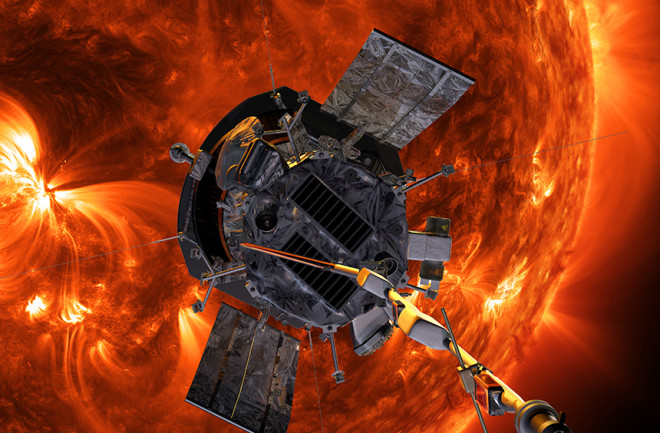The Parker Solar Probe, a spacecraft launched in 2018 on a mission to explore the sun's outer layers, is already revealing new insights about our star. Now, scientists have translated some of the probe’s measurements into funky sound clips that you can listen to on their SoundCloud page or in the embedded video below.
We're hearing (after some sound reconstruction) motions in the wind blowing off of the sun's surface. The whooshing and whistling noises are waves in the hot, electrically charged plasma that come off of the sun’s wispy outer layers, or corona, and stream through space as solar wind.
One of the Parker Solar Probe’s primary goals is to probe why the sun’s corona is so much hotter than the sun’s surface — and thus how the particles in the solar wind have so much energy. By studying these plasma waves, researchers hope to understand what processes are heating up the corona and accelerating the solar wind.
Hearing the Solar Wind
Though these audio clips were never sound, per se, the data does share some similarities with sound here on Earth. The Parker Solar Probe measures pressure waves in the particles that make up solar wind. In our daily lives, we hear pressure waves as sound.
The Parker Solar Probe doesn’t have a microphone on board, but its instruments can measure the frequencies and amplitudes of these waves in the solar wind. Scientists then turned those wave measurements into sound waves, creating clips of what the waves might sound like to the human ear.
The plasma waves that Parker Solar Probe is capturing are the result of particles interacting with magnetic and electric fields. When electrons spin around a magnetic field, they can generate pressure waves, which the spacecraft picks up on. This type of wave, called a Whistler wave, also forms in Earth's magnetosphere, the region around our planet that's dominated by Earth's magnetic fields.
Another type of wave the probe picked up in the solar wind is called a Langmuir wave. These are very high-frequency pressure waves — rapid fluctuations in densities of electrons that form when beams of electrons stream along magnetic fields. Translated into sound waves, the Langmuir waves here make an ethereal, high-pitched keening.
Surfing Plasma Waves
Understanding how particles interact with magnetic and electric fields may reveal what physical processes are heating up the corona and accelerating the solar wind.
Plasma waves, like those captured by the Parker Solar Probe and featured in these sound clips, are one possible explanation for this energy transfer process, according to Nour Raouafi, the project scientist for Parker Solar Probe at Johns Hopkins University’s Applied Physics Laboratory. Particles may be getting a boost by traveling on these waves, Raouafi said, like surfers riding ocean waves at the beach.
“Parker Solar Probe, by going to the source of the solar wind, is basically revealing to us a new picture of the young solar wind,” Raouafi said. “It's actually providing us with the missing pieces of the corona puzzle that we have been looking for over the last 60 years.”

